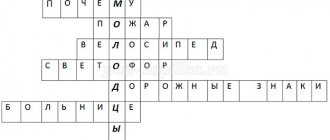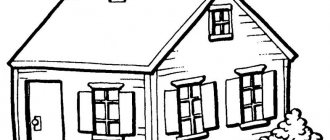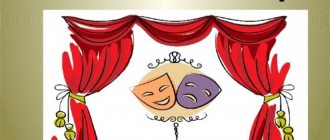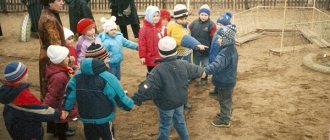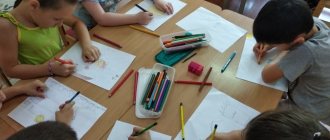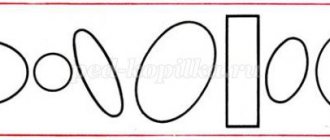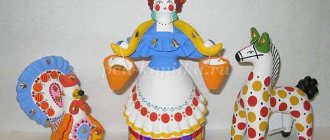Magic box
Summary of a dominant musical lesson for children of the preparatory group using musical
didactic games.
The “Magic Box” music lesson was designed to develop children’s musicality and ability to perceive music emotionally.
Training tasks:
consolidate ideas about the varieties of the dance genre, the rhythmic pattern of the mazurka and polka; to form modal tonal and pitch hearing.
Developmental tasks:
develop emotional responsiveness to musical works, the ability to understand the content and character of musical pieces, creative imagination through musical and rhythmic movements.
Educational tasks:
to cultivate love and interest in classical music and the work of P.I. Tchaikovsky.
Equipment:
piano, music center, flannelgraph.
Demo material:
music Box; “accordion” made of colored paper; Major and Minor dolls, Major and Minor hats; cube with images of musical instruments; snowflakes, fake snowball; diagrams of dance figures.
Handout: "
accordions" made of paper; white chiffon scarves; children's musical instruments.
Progress of the lesson
(Children enter the hall to the “March of the Wooden Soldiers” by P.I. Tchaikovsky, their attention is drawn to the music box.)
Music hands:
Guys, today I discovered this box of riddles.
If we guess them, the box will remain in our garden. There is no way we can do this without your help! Are you willing to help? (Children agree.)
The box is not simple, it is musical!
You, box, open quickly.
Try very, very hard to make it more fun.
Our box is full of secrets and songs,
She will reveal musical secrets to us.
(The teacher opens the box from which music sounds and takes out an “accordion” folded out of paper.)
Music hands:
This harmonica can perform magical transformations depending on the music!
If a polka sounds, it will turn into a skirt, if a mazurka sounds, it will turn into a fan, and if a waltz sounds, it will turn into a butterfly. (The teacher demonstrates the transformations of the “accordion”.)
Let's try it!
(In the musical and didactic game “Accordion-Talker”, children perform these transformations to the sounds of “Children’s Polka” by M.I. Glinka, “Nata Waltz” and “Mazurka” by P.I. Tchaikovsky.) Music
. hands:
Well done! How did you manage to accurately distinguish a mazurka from a polka?
Children:
She has her own rhythmic pattern, not the same as the polka.
Music hands:
Let's clap it to remember it better!
(The game “Repeat the rhythm” is played. Children clap the rhythmic pattern of the mazurka.)
Now let’s clap the rhythmic pattern of the first musical phrase of the polka and lay it out on a flannelgraph.
(Children clap the rhythmic pattern of a polka, and one child lays it out with icons indicating long and short sounds.)
Music. hands:
Is there anything else in the box?
(The teacher takes out the Major and Minor dolls.)
Guys, who is this? What fairy tale are they from?
Children:
These are Major and Minor from "Tales of Music".
Music hands:
Tell me, what is Major’s character?
What does he like? What can you say about Minor? (Children answer questions.)
Today these two musical modes will appear in our lesson.
(The teacher puts the Minor and Major hats on the two children.)
Minor:
Guys, guess which winter fairy tale this snowflake is from?
(Shows a snowflake.)
What dance did she dance with her friends?
Music hands:
A snowball will help Minor answer.
Whoever holds it in his hands will talk about music. (The “Waltz of Snow Flakes” by P.I. Tchaikovsky sounds; children pass the snowball to each other.)
Children:
The music is fabulous, magical, fast-paced, flying, exciting.
Music hands:
Guys, what instrument sounds suit this music?
Look at the cube and choose! (Children look at images of musical and noise instruments on the faces of the cube.)
Children:
A bell, a triangle, and bells are suitable. They have a “cold” sound.
Music hands:
How interesting it is to watch falling snowflakes!
Each performs its own dance, spinning in the air. Let's make a blizzard! Get into the circle quickly and hold hands tightly! You girls will spin around and turn into snowflakes! Hey boys, jump and jump, turn into a breeze! (A musical and didactic game “Convey the character of music with movements” is being held. To the music of P.I. Tchaikovsky “Waltz of Snow Flakes”, girls with scarves improvise a dance of snowflakes, boys imitate the wind; children who have chosen musical instruments play along with them.)
Music. hands:
It turned out to be a wonderful waltz of snow flakes!
Now you will spin around and turn into kids. (The teacher brings a snowflake to his ear.)
Winter comes to us cheerful, cheerful.
Children, the snowflake wants to hear a song. Major will help you guess it. (When performing the game exercise “Recognize the song by your lips,” Major sings without sound, the children guess and call the song “Come, Winter.”)
Music. hands:
Just now a blizzard was swirling here, we depicted it with movements, and now we’ll try to convey the howling of the wind in a voice.
(Children perform a phonopedic exercise.)
Blizzards whistled: “Oooh”
(glissando from bottom to top)
;
snow was flying: “Oh-oh-oh” (glissando from top to bottom)
.
She made the beds with frost: “Ah-ah” (glissando from top to bottom)
.
What is the character of this winter song? (Children answer.)
Try to convey the character of the music in your singing.
(Preschoolers sing the song “Come, Winter!”, music by E. Bolshakova.)
Major:
Now is the time to play in the snow and go sledding!
Music hands:
Let's continue to learn a fun dance!
(The teacher demonstrates diagrams of 3 elements of the 1st dance figure. Children are learning the dance-game “Russian Winter”, music by L. Olifirov.)
Music. hands:
Guys, what is the nature of this music?
Which mode can it be classified as: major or minor? (Children answer this and the following questions.)
Let's remember what types of dance genre do you know?
What dances did we listen to today? Which Russian composer's music did you try to depict with movements? Do you think you succeeded? Guys, you completed all the tasks! The music box remains with us, and it still contains many different secrets. (Surprise moment: Major and Minor give snowflakes to the children.)
Svetlana Kozhedub, music. Supervisor
MBDOU D/s No. 81 “Electronic”, Novorossiysk
GCD summary for the senior group (dominant activity)
Abstract of
the GCD for the senior group (dominant activity)
Topic: “Journey to the land of musical instruments”
Program content:
Continue to introduce children to various musical instruments: namely the violin. Talk about how it works and what it sounds like. Learn to recognize instruments by their appearance and sound timbre;
To consolidate the ability to play children's musical instruments, emphasizing the rhythmic and timbre originality of the music.
Develop singing skills, the ability to alternate movements: marching and easy running;
Improve children's speech, the ability to freely and clearly express their thoughts, enrich children's vocabulary with words: bow, violinist, triangles, metallophone, tambourine, rattles, spoons;
Develop the skill of playing a children's musical instrument individually and in an orchestra;
Foster a love of music and a sense of collectivism.
Methods and techniques:
conversation, demonstration, game method, individual work.
Preliminary work:
learning the song “Rain”, getting acquainted with the game “Cheerful Tambourine”, playing children’s musical instruments in the classroom.
Materials and
equipment:
Drum;
Musical instruments: triangles, metallophone, tambourine, rattles, spoons, musical hammer, maracas.
Umbrella with drawn tools;
Portrait of the composer A. Vivaldi;
Autumn picture;
Picture of a violin;
Music center, piano.
Musical accompaniment
: audio recording of the musical work “Autumn” by A. Vivaldi, “Walking and Running” by Tilicheeva, “Rain” by Partskhaladze.
GCD move
The music of Antonio Vivaldi's "Autumn" sounds quietly as the children enter the hall.
Musical director:
Hello guys! Today we have an unusual activity, we will go to the land of musical instruments. The magic drum will help us with this: we will march to the clear rhythm of the drum, and it’s easy to run on our toes to the fast rhythm.
The exercise “Walk-run” by Tilicheeva is performed
Musical director:
Well done guys, they performed the movement correctly and made no mistakes. Now we have arrived in the land of musical instruments. Look how beautiful it is here, there are many different instruments around. Do you hear some kind of music playing? (Children's answers)
Music by Antonio Vivaldi "Autumn"
(the music director suggests sitting on the carpet)
Musical director:
Guys, let's listen to music.
Did you find out what instrument it sounded like? (Children's answers: violin).
Musical director:
Yes, it's a violin. The violin plays in a symphony orchestra. No other musical instrument has such a quivering, subtle, high, clear sound.

